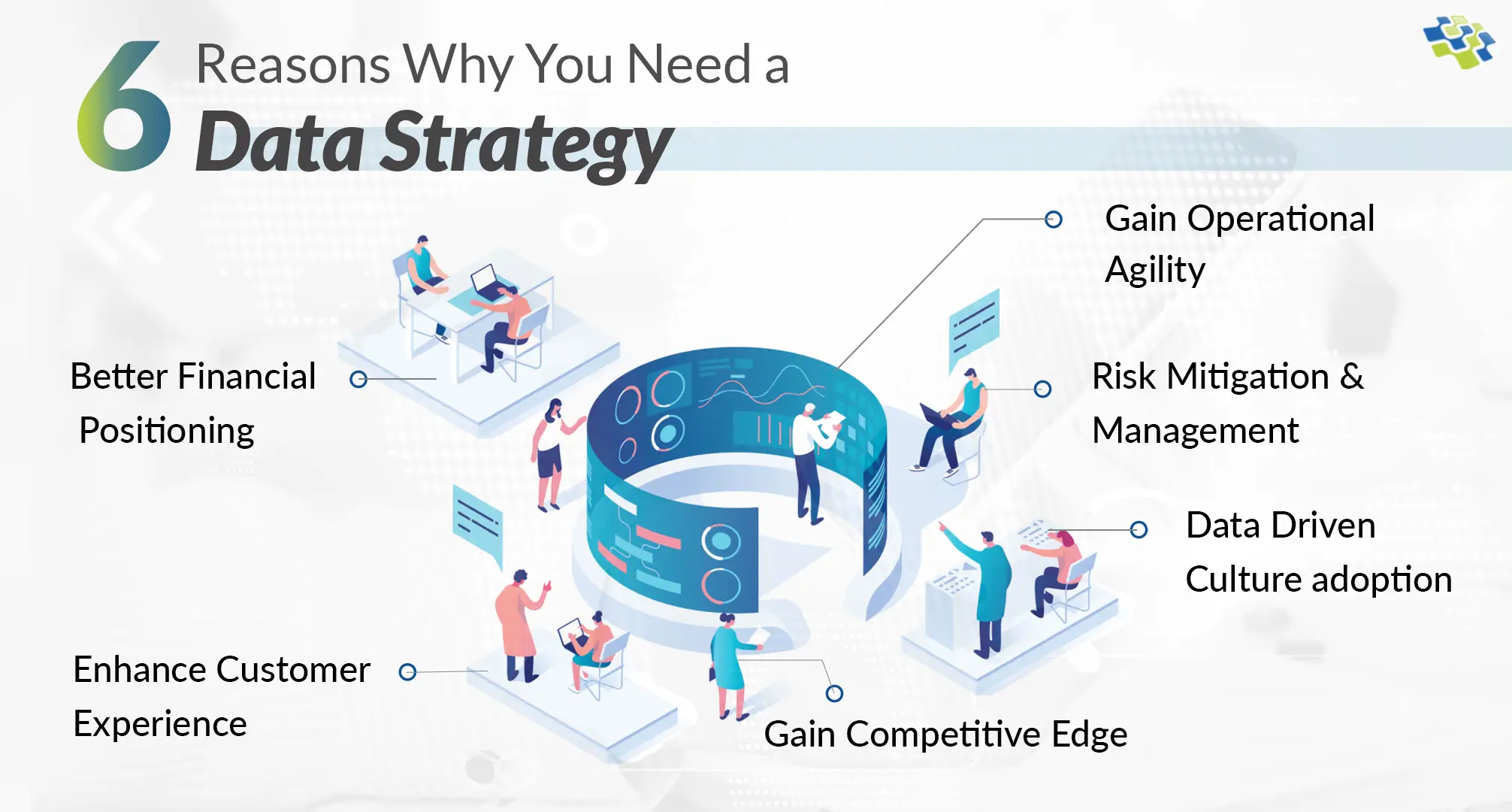Why Businesses Need a Powerful Data Strategy? 6 Ultimate Reasons
This strategy delineates data application, objectives, sourcing, storage, analysis, and implementation steps. It’s integral that this strategy aligns with the broader company goals and isn’t developed in isolation. By doing so, businesses can extract essential insights and devise actionable plans.

“In the modern business world, making decisions driven by data is of utmost importance. Businesses gather data to optimize productivity, informed decision-making, and customer engagement. The projected $105.08 billion big data analytics market by 2027 underscores data’s value-driven role in business advancement.”- Forbes
What is Data Strategy?
A data strategy is a structured and actionable plan of a framework designed to amplify the value of your data and drive success in the dynamic digital landscape. The goal is for your organization to utilize data for smarter, quicker, and more effective decision-making, making this the central focus of your data strategy. It’s crucial for your strategy to establish how data aligns with the broader strategic objectives of the organization and to outline the necessary processes for leveraging data to attain those objectives.
Elements of Data Strategy
To be effective, this strategy encompasses four core concepts:
- “Story”: This story encapsulates the essential components of a strategy, including vision, objectives, goals, and success metrics. It outlines what and why of the strategy, articulating the intended actions and their significance.
- “Oversight”: It addresses the necessary processes and procedures for developing and executing the data strategy. It defines roles and responsibilities, prioritizes tasks, manages risks, allocates resources, and oversees funding to ensure the strategy’s success.
- “Transformation”: Transformation involves the necessary changes to transition from the current state to the desired state. This encompasses decisions about design, creating roadmaps, and implementing data governance measures to facilitate the journey.
- “Culture”: Culture focuses on the human aspect of the plan. It includes managing workforce transitions, resource allocation, and ensuring effective training and communication strategies are in place to foster a cohesive approach.
Further Read: 5 Secrets of Successful Data Led Organizations
6 Reasons Why You Need a Data Strategy
In the contemporary data-centric landscape, a data strategy holds paramount importance for organizations. Ensuring that your data strategy aligns harmoniously with your business objectives is essential. Here are six compelling reasons why do you need a data strategy.
 1. Gain Operational Agility
1. Gain Operational Agility
Effective data processing is crucial for informed decision-making within organizations. Outdated data management methods can hinder this process, leading to negative outcomes. Additionally, data silos often emerge as various teams handle data separately, using different tools and approaches. These teams follow distinct principles when working on data extraction, modelling, transformation, aggregation, computation, and presentation for business use. Unfortunately, this approach involves extensive manual labor, limited reusability, and significant redundancy. However, a well-designed data strategy enhances operational efficiency and productivity. By swiftly converting and analyzing adaptable data, businesses can achieve specific objectives. This transformation of data into valuable insights is facilitated by an information architecture that outlines data gathering, storage, modification, distribution, and consumption methods, driving growth.
2. Risk Mitigation
Data privacy and security pose multifaceted challenges for businesses, including regulatory compliance, safeguarding proprietary information, and preventing both internal and external threats. Cyberattacks targeting client data present severe risks, with potential repercussions including substantial financial losses. Recent data indicates an upswing in the average cost of data breaches, surging to $9.44 million in 2023 from $9.05 million the previous year. These breaches can trigger litigation, regulatory penalties, reputational damage, and financial setbacks. To proactively manage these risks, businesses can establish robust data management protocols through an effective data strategy. This approach bolsters information security measures, reducing vulnerabilities and enhancing overall risk mitigation efforts.
3. Data-Driven Culture Adoption
The emergence of a data-driven culture is crucial in today’s corporate environment. Statistical evidence shows that companies embracing this culture are 3.5 times more likely to surpass their peers in revenue growth. A robust data strategy serves as the linchpin for instilling this transformation by fostering a mindset where personnel across all tiers base their decisions on data-driven insights. This methodology not only catalyses collaboration, innovation, and operational efficiency but also aligns teams to identify prospects, tackle complexities, and pivot nimbly in response to fluctuations. Thus, a meticulously formulated data strategy not only orchestrates the assimilation of data-centric practices but also empowers staff to leverage its potential adeptly.
4. Gain Competitive Edge
A solid data strategy is essential in the modern corporate environment for acquiring a competitive edge. Businesses may make wise decisions, spot market trends, and predict client wants by using data possibilities. This makes it possible to develop customized goods and services that raise client happiness and loyalty. Additionally, data-driven insights enable efficient resource allocation, cost savings, and operations simplification. A carefully thought-out data strategy is necessary for outperforming competitors and securing long-term success.
5. Enhance Customer Experience
Having data processing is essential, for making decisions within organizations. Using methods for managing data can hinder this process. Lead to negative outcomes. Another challenge that arises is the presence of data silos, where different teams handle data separately using tools and approaches. These teams follow principles when it comes to tasks like extracting, modelling, transforming, aggregating, computing, and presenting data for business purposes. Unfortunately, this approach often involves a lot of work, limited reusability, and unnecessary duplication. However, having a designed data strategy can improve efficiency and productivity. By converting and analyzing data businesses can achieve their specific objectives. This transformation of data, into insights is facilitated by an information architecture that outlines how the data should be gathered, stored, modified, distributed, and consumed – ultimately driving growth.
6. Better Financial Management
A strong data strategy is crucial, for management. With a defined plan in place, businesses can make decisions that promote growth. Recent research has shown that companies with a data strategy have an edge of 58%. Businesses understand the importance of collecting and analyzing data effectively for financial management. By doing they uncover opportunities to save costs increase investment returns and improve fiscal health. This systematic approach to data ensures insights, mitigates vulnerabilities, and enables responses to market changes.
Further Read: How can Organizations Transform to be Data Insight Driven
Data Asset Management: Essential for Data Strategy Roadmap
Data stands as an invaluable resource, often surpassing the significance attributed to physical or financial assets. Yet, numerous businesses fail to harness its potential, missing out on substantial value and strategic leverage. The likes of Tesla and Amazon exemplify today’s thriving enterprises that recognize data’s worth, elevating it to the status of a prized asset. By underestimating data’s potential, many companies forego heightened returns and competitive edges. In contrast, forward-thinking businesses grasp its pivotal role, propelling them to innovation and market leadership. Acknowledging data as a prized possession empowers firms to unlock novel insights, tailor strategies, and make informed decisions. Just as one safeguards tangible wealth, a data-focused approach secures future prosperity in the dynamic landscape of modern business.
Conclusion
As we’ve delved into the six compelling reasons, it’s evident that businesses wielding a potent data strategy secure a competitive edge, streamlined operations, and profound customer insights. To channel these advantages and steer your business toward triumph, aligning with a reliable data analytics company is paramount. At NextGen Invent, we specialize in transforming data into actionable insights, propelling growth and innovation. We guide our customers in shifting from perceiving data as an expense to embracing data asset management, unveiling the latent value within. In our experience, data asset management stands pivotal for every data strategy’s success, ensuring robust returns on data investments.
Enhance your business with the power of data strategy and analytics – contact us today and pave the way for a future of informed decisions and unparalleled success.
Stay In the Know
Get Latest updates and industry insights every month.
 1. Gain Operational Agility
1. Gain Operational Agility